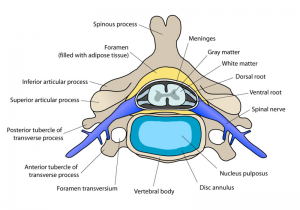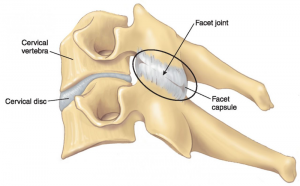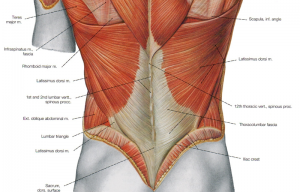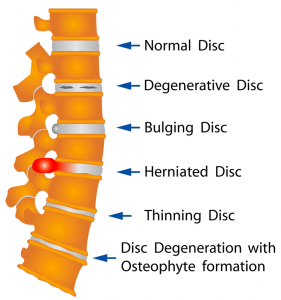- Spine Description
- Causes of Back Pain
- Back Pain & Treatment
- Stretching & Exercises
 The spine consists of bones (vertebrae), soft discs in between the bones, ligaments that hold the bones together in a column and the spinal cord and spinal nerves. There are also important spinal muscles with support the spine and control movement in the back.
The spine consists of bones (vertebrae), soft discs in between the bones, ligaments that hold the bones together in a column and the spinal cord and spinal nerves. There are also important spinal muscles with support the spine and control movement in the back.
The vertebrae are composed of two parts: a short cylinder of bone called the body and a posterior arch consisting of a pair of pedicles and a pair of laminae. There is a small hole between the body and the arch called the vertebral foramen, which allows the spinal cord to run through. The facet joint is the connection between two vertebrae. There are 33 vertebrae in the spinal column: 7 in the cervical (neck) area, 12 in the thoracic (mid back) area, 5 in the lumbar (low back) area, 5 fused together in the sacral area and 4 fused together in the coccygeal (tailbone) area.
The discs form a cushion between the vertebrae and are composed of an outer fibrous ring made up of collagen (annulus fibrosis) and an inner soft jelly center (nucleus pulposus) which is a shock absorber. 
The spinal cord, which carries information from your brain to the rest of your body, is protected by the vertebrae. Spinal nerves arising from the spinal cord exit through a space between the vertebrae (intervertebral foramen). This space may be narrowed by bone spurs or bulging discs which may result in a pinched nerve.
The ligaments are tough fibrous bands that hold together the vertebrae.
 There are many back muscles that contribute to core strength and stabilize the spine, allowing movement forward, backward and side to side. They include the erector spinae, multifidus and quadratus lumborum muscles.
There are many back muscles that contribute to core strength and stabilize the spine, allowing movement forward, backward and side to side. They include the erector spinae, multifidus and quadratus lumborum muscles.
The back has three natural curves: an inward curve in the lower or lumbar area (lumbar lordosis), an outward curve in the middle or thoracic area (thoracic kyphosis) and an inward curve in the upper neck or cervical area (cervical lordosis)
The curves protect the discs between the vertebrae and increase the shock absorbing and weight distribution ability of the spine.
 The majority of back pain is caused by a structural issue in one of the components of the back (bone, disc, ligament, spinal cord or nerves) or from muscle strain from unususal forces placed on the back.
The majority of back pain is caused by a structural issue in one of the components of the back (bone, disc, ligament, spinal cord or nerves) or from muscle strain from unususal forces placed on the back.
Lumbar strain
Lumbar muscle strain is the most common cause of low back pain. The muscles become strained after a twisting or jerking injury or after prolonged poor posture, excess body weight or lack of exercise and stretching.
Spondylosis
Spondylosis is a term that describes a number of changes to the structures of the spine. It includes loss of disc height, bony spur formation on the vertebrae (osteophytes) and break down of cartilage at the bone joints (osteoarthritis of facet joints).
Degenerative Disc
With wear and tear and age, the inner jelly center of the disc can lose its ability to hold water. This causes a loss of disc height. The ligaments may become looser with this decreased space between the bones and the bones may slide over one another (see spondylolisthesis below).
Disc herniation
Herniated discs occur in 4 % of all low back pain cases. The inner jelly center (nucleus pulposis) protrudes through a small defect in the outer fibrous ring. This often occurs at the back of the disc, which may cause compression of the spinal nerves exiting the spinal cord. The inner jelly could also rupture right through the outer collagen ring. Discs can herniate after trauma, heavy lifting or after age related wear and tear changes on the disc.
Treatment options include:
Limiting the activity that worsens the pain to allow the back to rest:
- Avoid prolonged sitting and heavy lifting
Proper posture:
- Standing: tight stomach muscles, slight bend in knee, tilt pelvis back, shoulders back
- Try not to stick out stomach and buttocks
- Try not to slouch forward
- Rest one leg on a low stool if standing for prolonged periods
- Sleeping: avoid sleeping on stomach or with too many pillows behind head
- May use a pillow under knees when lying on back or between
kneed when lying on side
- May use a pillow under knees when lying on back or between
- Lifting: bend your knees, not your back and hold objects close to
body - Twisting: keep shoulders, hips and feet aligned when turning to one
side - Sitting: use a good lumbar support and have knees level with the
hips
Pain control:
- Anti-inflammatories: ibuprofen (advil, motrin) or naproxen (aleve)
- Tylenol
Low impact cardio exercise
Stretching and exercises will increase flexibility and strength in order for the back to recover and prevent future injuries or recurrences
- Lying hamstring stretch: lie flat on the floor maintaining your normal lumbar curvature. Pull on the elastic band or towel until a stretch is felt in your hamstring muscle. Hold for 10 sec, lower and repeat. With each repetition, try and pull your leg farther forward. You should not experience any back pain with this exercise. Follow the video for 10 repetitions
- Gluteal Stretch: Lie on your back with both knees bent. Rest the ankle of one leg over the knee of your other leg. Grasp the thigh of the bottom leg and pull that knee toward your chest. You should feel a stretch along the buttocks and outside hip of your top leg.
- Quadruped arm/leg raise: on hands and knees. Tighten abdominal muscles. Raise one arm and opposite leg, hold for 5 sec. Lower and repeat on other side. Repeat 10 times each side.
- Back bridge: lie on your back on the floor with your knees bent and your feet flat on the floor. Place your arms by your side or out to the sides. Raise your hips of the floor by pushing against the floor with your heels until your body forms a straight line from your shoulders to your knees. Hold the position for up to 30 seconds. Lower your body slowly back down to the starting position. Follow the video for 10 repetitions. Take a rest and complete 2 more sets of 10 repetitions resting for 1 min between each set.
- Front plank: lie face down on the floor. Lift your body up onto your toes and your forearms with your elbows bent. Form a straight line from your shoulders to your ankles. Contract your abdominal muscles and hold this position for 30 seconds or as long as you can. Slowly lower your body back to the ground.
- Side plank: lie on your side with legs, shoulders and hips in straight line. Prop yourself onto forearm and lift your lips off the floor. Hold for 15 sec then lower. Increase the time you hold each repetition.
- Knee to chest: lying on back with knees bent, pull both knees in to chest. Hold for sec and repeat times.
- Prone extension: lie face down with palms on a firm surface. Push up with arms and extend your elbows so your arms are straight, head and shoulders are off ground but hip and legs are in contact with floor. Hold for 1-2 sec, lower and repeat.
- Lying hamstring stretch
- Gluteal Stretch
- Quadruped arm/leg raise
- Back bridge
- Front plank
- Side plank
- Knee to chest
- Prone extension
- Lying hamstring stretch
- Gluteal Stretch
- Quadruped arm/leg raise
- Back bridge
- Front plank
- Side plank
- Knee to chest
